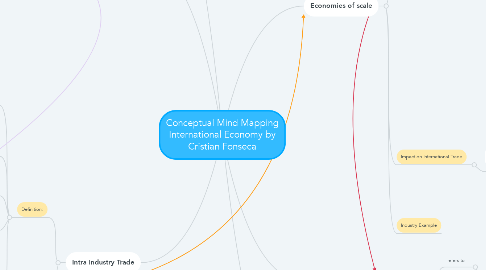
1. Economies of scale
1.1. Definition:
1.1.1. condition
1.1.1.1. Where more units of a product can be produced in a larger scale
1.1.1.1.1. Results on
1.1.1.1.2. Adam Smith identifid key points
1.2. Impact on International Trade
1.2.1. When production in an industry have achieved an economy of scale
1.2.1.1. it can result in
1.2.1.1.1. Improvements in world productive efficiency
1.2.1.1.2. Welfare benefits that accrue to all trading countries
1.2.1.1.3. Advantage over smaller businesses
1.2.1.1.4. Fewer resources available for solving and reaching other necessities.
1.3. Industry Example
2. Cost of Production
2.1. Definition:
2.1.1. refers to
2.1.1.1. The costs incurred by a business from manufacturing a product or providing a service.
2.1.2. Can include
2.1.2.1. Expenses such as labor, raw materials, consumable manufacturing supplies, and general overhead
3. Products Differentiation
3.1. Definition:
3.1.1. Strategy
3.1.1.1. Distinguish a product or service from other that is located in the market
4. Imperfect Competition
4.1. Definition:
4.1.1. is a competitive market situtation
4.1.1.1. There are many sellers
4.1.1.2. Selling dissimilar goods
4.1.1.3. Fight for market share
4.1.1.4. Are protected by barriers to entry and exit
4.1.2. Can be found in the following types of market structures:
4.1.2.1. Monopolies
4.1.2.2. Oligopolies
4.1.2.3. Monopolistic Competition
4.1.2.4. Monopsonies
4.1.2.5. Oligopsonies
5. Intra Industry Trade
5.1. Definition:
5.1.1. explains
5.1.1.1. Economic Convergenge
5.1.1.2. The economic divergence in the post-war period
5.1.2. Results from
5.1.2.1. Consideration of economies of scale
5.1.2.2. Imperfect competition
5.1.3. Involves
5.1.3.1. Flows of goods with similar factor requirerments
5.1.4. Countries thaat are net exporters of manufactured goods
5.1.4.1. Embodyying sophisticated technology also purchase such goods from other countries
5.1.5. Reasons for Intraindustry Trade
5.1.5.1. Transportation Costs
5.1.5.2. Overlapping demand segments in trading countries
5.1.5.3. Economies of scale
5.1.5.4. Countries with lower costs due to specialization
5.2. Industry Example
5.2.1. .
5.2.1.1. As South Korea moves to the right of point A
5.2.1.1.1. The relative cost of steel will deacrese
5.2.1.1.2. Until South Korea totally specializes in steel production at point C
5.2.1.2. As the US moves to the left of point B
5.2.1.2.1. The relative cost of computers continuest to fall
5.2.1.2.2. Until the US totally specializes in computers
6. Conclusion
6.1. The relation and link can be found at
6.1.1. As economies of scale get achieved, the cost of production of an industry will reduce drastically
6.1.1.1. This is acheived by an specialization on each product, this mean they will reduce their portfolio and the product differentiation.
6.1.2. With the increase of new trends of international trade
6.1.2.1. Very similar countries in term of technologies or holding, can engage in trade. It shows how a country can be both an exporter and an importer of the same commodity.
6.1.2.1.1. This relates product differentiation and intra-industry trade
6.1.3. The intra-industry trade that results
6.1.3.1. From consideration of economies of scale and imperfect competition can explain both the economic convergence and the economic divergence in the post-war period
